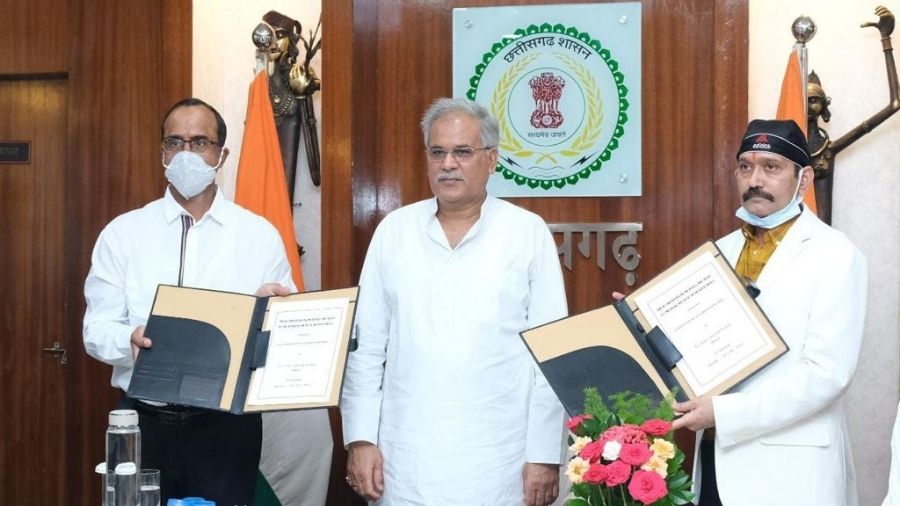Fourteen Chhattisgarh districts on Friday signed MoUs with the Indian Institute of Millet Research, Hyderabad for boosting production of ragi, kodo and kutki in the state as chief minister Bhupesh baghel launched the Millet Mission programme.
Addressing the event at his Raipur office, Baghel said that Chhattisgarh will become the millet hub of the country in the coming times. He said that under Millet Mission, an initiative has been taken to give the farmers the right price for small cereal crops, provide input assistance, procurement arrangements, processing.
"Like minor forest produce, we want to make small grain crops also the strength of Chhattisgarh," he said.
Under the programme, the IIMR will help Kanker, Kondagaon, Bastar, Dantewada, Bijapur, Sukma, Narayanpur, Rajnandgaon, Kawardha, Gaurela-Pendra-Marwahi,Balrampur, Koriya, Surajpur and Jashpur with technical know-hows, availability of high-quality seeds and establishment of a seed bank in Chhattisgarh. Arrangements will be made for training the farmers of Chhattisgarh through Krishi Vigyan Kendra for spreading the scientific technology developed at the national level related to millet production by IIMR Hyderabad at the field level.
"Minor cereal crops like Kodo, Kutki and Ragi are mostly sown in our forest areas. Crops like Kodo, Kutki and Ragi are rich in nutrition. There is a good demand for these in the country. These are sold at very good prices in urban areas. But Kodo, Kutki and Ragi grown in Chhattisgarh have not been able to come out of Vananchal," Baghel said.
"Till now, neither the support price of these crops was fixed, nor was there any arrangement for its purchase. Even after producing such an important and valuable crop, the farmers who grew it remained poor," he added.
Baghel said that the purchase of minor cereal crops would be done through the Van Dhan societies of Chhattisgarh Minor Forest Produce Co-operative Federation. After processing these crops, they will be used in schemes like mid-day meals, public distribution systems and nutrition programmes.
With this, arrangements will be ensured to take the finished products to the markets of the metropolitan cities. It has also been decided to manage Rs 170 crore 30 lakh for the next five years of Millet Mission through DMF and other means. He said that under Millet Mission, farmers growing Kodo-Kutki and Ragi crops would be given an input assistance of Rs.9000 per acre and Rs.10,000 per acre for growing Kodo-Kutki and Ragi instead of paddy.
The Chief Minister said that like minor forest produce, large-scale employment opportunities would be created at the local level due to value addition of small-grain crops.
"Two processing units have been established at Kanker and Durgukondal. Sisters of Self Help Groups are getting employment from this. Like minor forest produce, we also want to make small grain crops the new strength of Chhattisgarh. In the next phase, MoUs will be signed with more such districts, where production of Kodo, Kutki and Ragi is abundant," he said.
IIMR Director Dr. Vilas A. Tonapi said that in the present times, there is a need to increase food diversity in our diet to address the problem of lifestyle diseases and malnutrition. "The Millet Mission starting in Chhattisgarh will prove to be a milestone in this direction. He said that it is a good initiative by the state government to provide input assistance to the farmers engaged in millet production in the state of Chhattisgarh," he said.
He added that the year 2023 will be celebrated as the International Year of Millet. Through the Millet Mission, Chhattisgarh will be successful in making a mark as a Millet Hub in the country by the year 2023.
The Managing Director of Chhattisgarh State Minor Forest Produce Co-operative Federation, Mr. Sanjay Shukla said that IIMR specialists will be posted in the districts by the State Government who will guide the farmers to increase the production of millets. Senior consultant will also be appointed at the state level. He will act as a master trainer. He said that seed banks for small grain crops would be established in Bastar, Surguja, Kawardha and Rajnandgaon.











